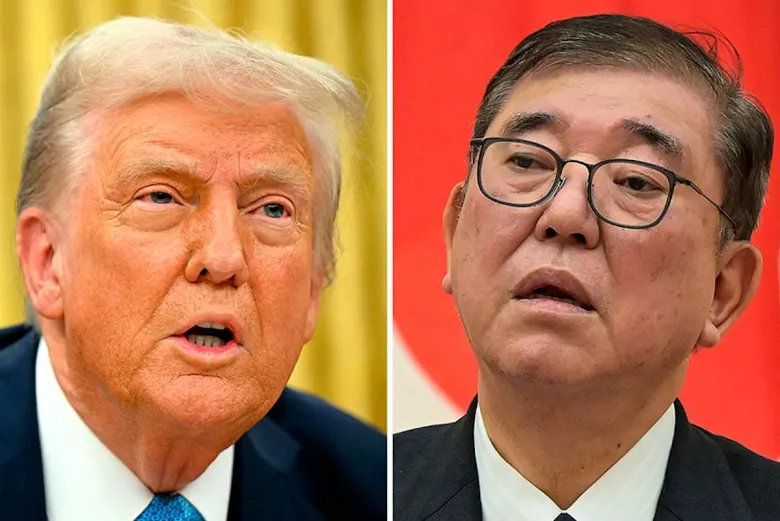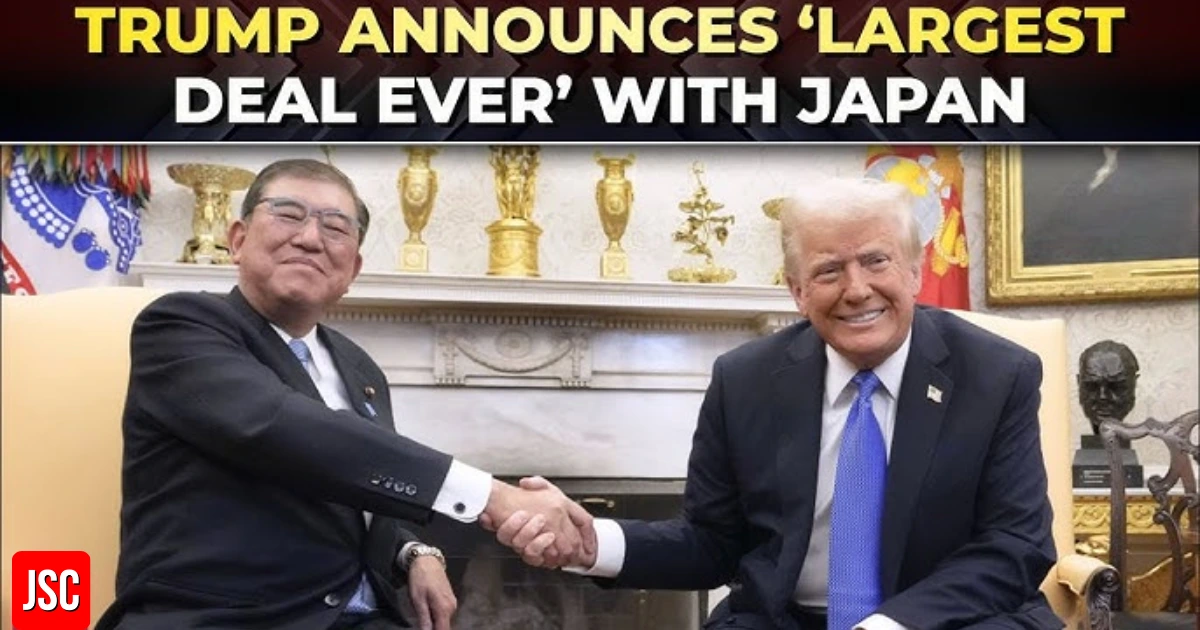President Trump has announced a $550 billion trade agreement with Japan—the largest in U.S. history. Discover what’s in the deal and how it impacts jobs, cars, agriculture, and global trade.
Table of Contents
Trump Announces ‘Massive’ Trade Agreement with Japan: What It Means for the U.S. Economy and Global Trade
In a move hailed as “the largest trade deal in history,” President Donald Trump has announced a sweeping new trade agreement with Japan that reshapes economic relations between two of the world’s most powerful economies. With a value of $550 billion and wide-reaching implications across the automotive, agriculture, and tech sectors, the deal marks a landmark moment in U.S.-Japan relations—and in the Trump administration’s broader trade strategy.
Let’s break down the key elements of this new agreement, what it means for U.S. workers and businesses, and how it positions the U.S. and Japan on the global stage.
A Long-Awaited Breakthrough
After months of tense negotiations and missed deadlines, President Trump revealed the agreement Tuesday night during a reception with Republican lawmakers.
“I just signed the largest trade deal in history… and it’s a great deal for everybody,” Trump declared, adding that the negotiation process had been “long and hard.”
The announcement caught many by surprise, especially given the chilly tone of previous trade talks. Just a few weeks earlier, Trump had warned Japan of potential tariff increases, calling them “tough negotiators” aboard Air Force One. But that tension has now been replaced by celebration.
What’s Inside the Deal?
The agreement includes several major provisions:
1. Reciprocal 15% Tariffs
U.S. importers will now pay a 15% reciprocal tariff on Japanese goods. Crucially for Japan, this includes automobiles and car parts, giving them an edge over other countries still subject to 25% levies on auto exports.
2. $550 Billion Investment into the U.S.
Japan will inject $550 billion into the U.S. economy, according to President Trump. This investment will come in the form of equity and loans, largely to support Japanese businesses in high-priority U.S. industries such as pharmaceuticals and semiconductors.
“The U.S. will receive 90% of the profits,” Trump emphasized, positioning the deal as a major win for American economic interests.
3. Increased Agricultural Access
Japan will now allow more imports of U.S. rice, cars and trucks, and other agricultural products. This is significant, considering past barriers created by Japan’s highly regulated and opaque rice import system.
4. Automotive Sector Advantage
Ryosei Akazawa, Japan’s chief negotiator, described the agreement as making Japan “the first in the world to reduce tariffs on automobiles and parts without volume restrictions.”
This provision puts Japanese automakers like Toyota, Honda, and Nissan in a stronger position compared to their global competitors.
Japanese Markets React with Optimism
The impact of the announcement was immediate. On Wednesday, the Nikkei Index surged 3.7%, hitting a one-year high as investors celebrated the deal. Shares of major Japanese automakers saw notable gains.
A photograph posted by Akazawa from the White House showed him pointing at an image of Trump and Japanese Prime Minister Shigeru Ishiba during prior negotiations, captioned simply:
“Mission Accomplished.”
Trump’s Message to Americans: ‘Jobs, Jobs, Jobs’
At the heart of Trump’s announcement was a pledge that the deal would create hundreds of thousands of American jobs.
“There has never been anything like it… this deal opens the door to U.S. exports, manufacturing, and farming like never before,” Trump posted on Truth Social.
Key beneficiaries include:
- U.S. rice farmers, who have long been blocked from full access to Japan’s market
- Car manufacturers, particularly those exporting auto parts
- High-tech industries, set to benefit from Japanese capital inflows
Why Japan Agreed Now

Japan’s government, led by Prime Minister Ishiba, called the deal “the lowest trade surplus figure to date” with the United States and hailed it as a model of cooperation.
The decision likely reflects pressure from multiple directions:
- The U.S. threat of 25% tariffs, paused temporarily in April, loomed large
- Internal economic pressure, including a rice shortage in Japan, made U.S. imports more appealing
- Geopolitical strategy, with Japan increasingly caught between U.S.-China trade tensions
Akazawa stressed that the agreement does not sacrifice Japanese agriculture, and said that the rice import share would rise, but in a controlled manner.
Rice and Cars: Sticky Issues Resolved
Two key sticking points—rice imports and automobile exports—were major hurdles in prior talks.
- In 2021, USTR reports criticized Japan’s rice trade system as “nontransparent”
- Trump previously claimed, “We didn’t give them one car in 10 years”
While Japan did import over 16,700 American vehicles last year, the new deal promises to open up more space for U.S. autos and eliminate volume caps on Japanese vehicles into the U.S.
Still Pending: Steel and Aluminum
One area not yet resolved is the 50% tariff on steel and aluminum, which remains in place.
Akazawa confirmed that Japan and the U.S. will continue discussions on these industries. With Japan being a major producer of industrial materials, future negotiations here could be just as consequential.
Energy: A New U.S.-Japan Gas Pipeline Venture
Trump also announced that Tokyo and Washington are nearing a deal for a joint gas pipeline project in Alaska. This move aligns with the Trump administration’s broader strategy to:
- Reduce U.S. dependence on foreign oil
- Attract foreign direct investment
- Strengthen regional energy security, especially in Asia-Pacific
“They’re all set to make that deal now,” Trump said, though details remain sparse.
A Global Message: Pressure on China and the World
The Trump administration has frequently used trade deals to pressure other nations—particularly China—to reduce trade volumes and dependency.
By locking in Japan, a key Chinese trading partner, the U.S. sends a strong message to global markets: that Washington still commands strategic economic alliances despite tensions.
Analyst Reactions: Mostly Positive, Cautiously So
Mary Lovely (Peterson Institute):
“The deal relieves Japan of the 25% tariff threat… agricultural liberalization is a win for Japanese consumers.”
U.S. Treasury Secretary Scott Bessent:
“A good deal is more important than a rushed deal… a mutually beneficial agreement remains within reach.”
Experts have also pointed out that Japan’s role as America’s largest foreign creditor—holding over $1.1 trillion in U.S. Treasuries—likely gave Tokyo leverage in talks.
Why This Deal Matters for You
Whether you’re a farmer, business owner, or simply following global headlines, this trade agreement could affect:
- Prices on Japanese cars and electronics in the U.S.
- Availability of high-quality Japanese rice and produce
- Job creation in American tech, agriculture, and auto sectors
- Stability in global trade amid tensions with China
Looking Ahead
This U.S.-Japan deal is far from the end of the road. Other countries are now watching closely to see whether similar agreements may follow.
Trump hinted at more trade pacts in the pipeline with South Korea, the EU, and India. But for now, the Japan deal stands as a significant political and economic victory heading into the next election cycle.
FAQs
1. What is the total value of the U.S.-Japan trade deal?
The deal is valued at $550 billion, including Japanese investments and tariff concessions.
2. What industries are most affected?
Key sectors include automobiles, agriculture, pharmaceuticals, and semiconductors.
3. Will U.S. rice exports to Japan increase?
Yes. Japan has agreed to open its market further to U.S. rice and other agricultural goods.
4. Does the deal resolve steel and aluminum tariffs?
Not yet. Discussions on those items are ongoing and were not included in this agreement.
5. How does this affect Japan’s relationship with China?
Japan’s alignment with the U.S. could strain its trade ties with China, but officials believe it will strengthen Japan’s global trade influence overall.
